The problem of micro beads and micro plastics is not new to the world. From the past 50 years, there has been many damages caused because of micro plastic pollution due to contact lens. The issue came out in 2012 and has attracted a lot of awareness from the public.
Plastic constitute a major part of debris found deep under the oceans or lakes. Plastic waste can be regarded as micro plastic waste when it is broken down in small shards of size less than 500 microns. There are various sources of micro plastics like smaller pieces of plastic debris; formed out of the degradation of large pieces of plastic.
A look at the current situation of Plastic Pollution
 Many health and beauty products like toothpastes and cleansers are another sources of micro plastics as they contain tiny pieces of polythene pieces. These particles are so small that they may pass out through the filtration system and flow out in oceans and seas causing threat to marine life.
Many health and beauty products like toothpastes and cleansers are another sources of micro plastics as they contain tiny pieces of polythene pieces. These particles are so small that they may pass out through the filtration system and flow out in oceans and seas causing threat to marine life.
Many people are dependent on contact lenses so that vision is enhanced. These are devices meant for sight correction, but are not meant to be used for lifetime. Most of them are made to be used for just a day. Sooner they are of no use, they are to be disposed.
Have you ever wondered what happens to the lenses when you flush them away?
Researchers have confirmed that the fragments of micro plastics in the ocean soak up the contaminants if disposed in wastewater treatment plants.
Tossing down the used contact lenses in the toilet or sink may lead to micro plastic water pollution, as per the researchers of the University of Arizona State. According to them it is serious matter of concern and the public should be made aware of this issue.
The alarming numbers
 It has been recorded that about 7- 15 million of contact lenses made of soft plastic are used every year in US and this number is on rise every year as more number of people are relying at contact lenses in their daily routine.
It has been recorded that about 7- 15 million of contact lenses made of soft plastic are used every year in US and this number is on rise every year as more number of people are relying at contact lenses in their daily routine.
These contact lenses are transparent in nature due to which it is hard to spot in a complicated waste water system. This makes their treatment very challenging in a water treatment plant.
Micro plastic pollution due to contact lens at market place
It has been found out that more than 93% of the bottled water contains micro plastics at a global level. It is fine that some of the lenses are accidently dropped or tossed in garbage. But most of the time people choose to flush them out as it is never guided how to dispose them off after use.
Recent surveys have concluded that one out of five people wearing lenses; flush out their contact lenses in toilet leading to micro plastic pollution. This is quite a huge number.
Leaving the treatment plants intact
 Lenses, if flushed away, pass through the sewer system and end up in wastewater treatment plant. They become a part of sludge as they are generally heavier then water. When undergone through mechanical handling, only the outer covering of the lens gets fragmented. The microbes cannot decompose the polymer network of the lens.
Lenses, if flushed away, pass through the sewer system and end up in wastewater treatment plant. They become a part of sludge as they are generally heavier then water. When undergone through mechanical handling, only the outer covering of the lens gets fragmented. The microbes cannot decompose the polymer network of the lens.
Micro plastics pollution due to contact lens in local water bottles
Municipalities may incinerate or put sludge over the landfill sites. The plastic dumped there may enter into the food chain by the way of Earthworms residing in the soil; or, may go down into oceans, lakes or rivers during rains. Plastic may directly enter the waterways at the time of overflows in water treatment plants. These micro plastics can get accumulated in the blood stream as toxic chemicals. Also the plastic used in contact lenses is different from those used in textiles or car batteries.
Contact lenses are manufactured with a blend of fluoropolymers, silicones and methyl methacrylate, which turns out to a soft texture allowing the passage of oxygen in the eye. Such type of plastics is able to absorb almost all the contaminants like polychlorinated biphenyls, heavy metals and toxic chemicals. The Environment is continuously degrading by the micro plastic pollution due to contact lens.
Why are micro plastics bad?
 What makes the situation worse is that contact lenses are heavier than water; and, they sink deep into the aquatic zones. Micro plastic in the ocean are thus eaten up by the thriving marine life there and results in their extinction as it is mere a plastic for them. Tiny planktons and fish often mistake such plastics as their food and feed on them.
What makes the situation worse is that contact lenses are heavier than water; and, they sink deep into the aquatic zones. Micro plastic in the ocean are thus eaten up by the thriving marine life there and results in their extinction as it is mere a plastic for them. Tiny planktons and fish often mistake such plastics as their food and feed on them.
But it is not less than poison for them; It is absolutely indigestible to their digestive systems. Even the terrestrial ecosystem is being damaged by them. It has been estimated that about 2 pounds of wastewater sludge is composed of contact lenses in US every year.
How can we deal with such a problem?
It is very obvious that people will wear contact lenses and won’t discard its use. But the wearers should be careful about its disposal once they aren’t needed anymore. There is a simple solution to dispose off this, i.e. to chunk out it in a bin, rather than flushing it down.
The manufacturers as well should put a label over the packing of the lenses containing the details of the ways of their disposal. Their persistent and pervasive nature is a matter of global concern as it poses high risk to human survival. This is the answer to why are micro plastics bad.
A concluding note
To stop micro plastic pollution due to contact lens, such polymer should be used to create these lenses which can be finely tuned but at the same time are degradable and labile for the environment. Stop down the flushing of contact lenses right at this moment to control a major extent of environmental hazard.

